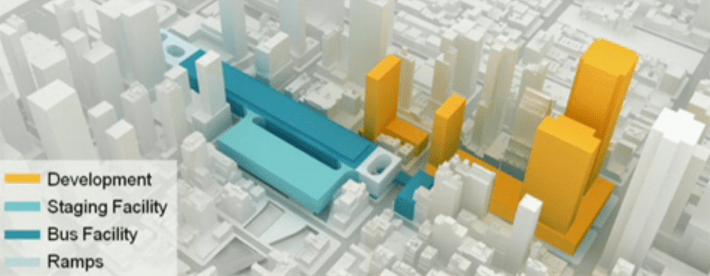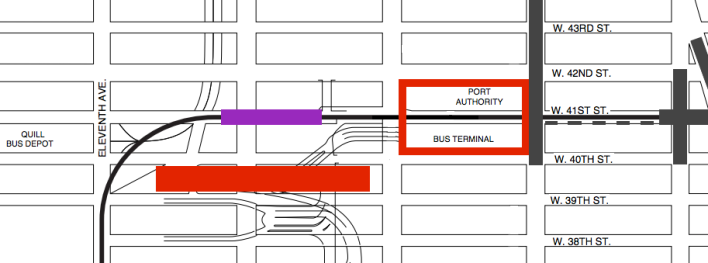
The effort to replace the aging and overcrowded Port Authority Bus Terminal continues to suffer from the New York region's inability to coordinate its transit mega-projects.
The bus terminal already handles more than 225,000 passengers per weekday and cannot accommodate all the bus traffic that crosses the Hudson in Midtown. Demand is expected to increase about 50 percent by 2040, but there is no plan in place to build a new terminal.
A working group of four Port Authority commissioners has been considering five concepts to replace the bus terminal with a modern facility that can handle many more passengers. Today they recommended a plan to the full board, but the full board didn't endorse the working group's proposal, putting off a vote until a later date, pending further study.
The almost-recommended-plan, known as Concept 3, would move the bus terminal one block west. It appealed to the working group for a variety of reasons, including the fact that unlike the other four options, the Port Authority would not have to build a temporary terminal to handle passengers while the new terminal is under construction.
"It doesn’t require an alternate facility and the complete disruption of the passenger experience for a decade," said Commissioner Kenneth Lipper. "It's less expensive, and it opens up billions of dollars in real estate." Selling off development rights could help finance the project, which has been estimated to cost as much as $10.5 billion.
But moving the bus terminal west poses serious problems, due in part to the mistakes of past projects.
Today, bus passengers have direct access to the A, C, and E trains on Eighth Avenue, with access to other trains at Times Square through a block-long underground passageway. Under Concept 3, most of the passenger and boarding areas would be on the block between Ninth Avenue, Tenth Avenue, 39th Street, and 40th Street. That's a full avenue west and one street south of the existing bus terminal.
To bridge the gap, the plan includes pedestrian overpasses connecting the new bus terminal with office and retail developments on the old Port Authority site, where passengers would go underground to swipe their MetroCards. The walk to most Times Square subway lines for more than 230,000 passengers each day would increase from about five minutes to at least 10 minutes in each direction.

The new bus terminal would be located just south of where the city, as part of the 7 train extension to Hudson Yards, at one point planned to build a subway station. That station was cancelled by the Bloomberg administration in 2007 to reduce costs. The subway was ultimately built to allow an infill station, but construction would be much more disruptive and expensive than if it had been included in the original project.
“There is no way that terminal is going to work west of Ninth Avenue unless you build the [subway] station,” Community Board 4 chair Christine Berthet told Streetsblog.
Taxi pick-ups and drop-offs for the bus terminal, which currently occur on Eighth Avenue, would likely shift west as well, affecting city streets. "Ninth Avenue is already completely jammed with Lincoln Tunnel queues,” Berthet said. "How does that work?"
Another drawback is that the new terminal probably won't be big enough to handle all of the buses that could use it. Inter-city buses to destinations beyond the New York region would have to be moved to a still-undetermined location. (Only one of the five concepts the working group considered could accommodate inter-city buses; it was also the most expensive option.)
Port Authority Vice Chair Scott Rechler suggested moving both inter-city and commuter bus terminals outside Manhattan, where passengers could transfer to a rail connection. While Berthet, who has combatted the growing bus traffic in her neighborhood, supports the idea, most commissioners were not swayed by an option that imposes a two-seat ride to Manhattan.
Of course, shifting tens of thousands of bus commuters onto rail across the Hudson River would impose other infrastructure costs. The current train tubes to Penn Station, like the bus terminal, are aging and at capacity, and the region's leaders are just beginning to discuss how to fund a new rail tunnel.
Local City Council Member Corey Johnson urged the Port Authority to widen its lens. "I think one thing that the Port Authority needs to look at is entire west side of Manhattan and how our transportation options and future infrastructure projects fit together," he said. Johnson’s district includes the bus terminal, the 7 train extension and Penn Station, which a new rail tunnel would serve. “These are all things that need to be thought about in a master plan type of way, because they all impact each other.”
Commissioners seemed to acknowledge today that they are ill-equipped to plan for regional commuters, due to the absence of coordination with other agencies and a lack of data. Nor has the bus terminal become a noticeable priority for Governor Cuomo, Governor Christie, or Mayor de Blasio.
At the same time, the commissioners view fixing the overcrowded bus terminal as an urgent issue.
“This is the biggest decision, in my 10 years as a commissioner, that I will make," said commissioner Tony James. "But we need to move forward. I agree, we can’t study this to death."





